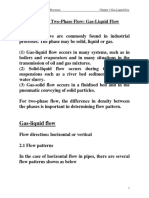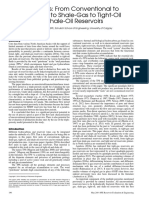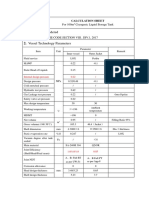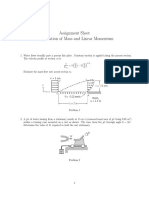Full Report Kinematic Viscosity
Full Report Kinematic Viscosity
Uploaded by
Kyle PongCopyright:
Available Formats
Full Report Kinematic Viscosity
Full Report Kinematic Viscosity
Uploaded by
Kyle PongCopyright
Available Formats
Share this document
Did you find this document useful?
Is this content inappropriate?
Copyright:
Available Formats
Full Report Kinematic Viscosity
Full Report Kinematic Viscosity
Uploaded by
Kyle PongCopyright:
Available Formats
TITLE:
MEASUREMENT OF KINEMATIC VISCOSITY
1.0 REPORT SUMMARY 2.0 THEORY Dynamic Viscosity As a fluid moves, a shear stress is developed in it, the magnitude of which depends on the viscosity of the fluid. Sheer stress () can be defined as the force required to slide one unit area of substance over another. Thus, is a force divided by an area and can be measured in the unit of N/m2 or Pa. In fluid such as water, oil, alcohol or other common liquids the magnitude of the shearing stress is directly proportional to the change of velocity between different positions in the fluid. = (v/y) where : = sheer stress v = change in velocity of fluid particle y = distance travelled by fluid particle = constant of proportionality, called dynamic viscosity (Eq 1)
For the purpose of clarity, let give the symbol d for dynamic viscosity. Unit System SI system US System cgs System Dynamic Viscosity, (d ) Units N.s/m , Pa.s or kg/m.s lb.s/ft2 or slug (ft.s) Poise = dyne.s/cm2 = g/(cm.s) = 0.1 mPa.s
2
Centipoise = poise/100 = 0.001 Pa.s = 1.0 mPa.s Kinematic Viscosity Many calculations in fluid mechanics involve the ratio of the dynamic viscosity to the density of fluid. k = d / where : k = kinematic viscosity d = dynamic viscosity = density of fluid Unit System SI System US System cgs System
2
(Eq 2)
Kinematic viscosity, ( k) Units m /s ft2 /s Centistokes = stoke/100 = 1X10-6 m2 /s =1 mm2/ s
The dimension for kinematic viscosity is L2/T.
Measurement of Viscosities The direct measurement of viscosity is based on the correlation, = R4tP / 8VL where : V = volume of liquid, cc t = flowing time, second r = radius of capillary tube, cm L = length of pipe, cm P = pressure N / cm2 = absolute viscosity, poise The direct measurement of absolute viscosity is difficult. For simplicity, the measurement of viscosity normally used the same equipment and two types of liquid. Using the following relationship :
1
(Eq 3)
= (1t1) / (2t2)
(Eq 4)
where : = density of fluid, gm/cc t = time taken to flow in the capillary, second
1, 2
= type of fluid used
Basically the method used to measure the viscosity is by measuring the time taken for the liquid to flow in the capillary at a given temperature.
k
= ct
k
(Eq 5)
where :
= kinematic viscosity
c = viscometer constant, cts/s t = time of flow,
3.0 PROCEDURES Determination of Kinematics Viscosity
a) A pipette was used to pour 10ml of kerosene into the capillary glass viscometer. The
capillary glass viscometer is put into the bath to equalise the temperature of the kerosene and instrument, which is 40C. b) A vacuum pump was used to suck water in the capillary glass viscometer until the water level is about 5mm above the level in the viscometer. c) The time taken for the water to flow from a high level to the low level of the viscometer was measured. d) The steps are repeated at temperature of 100C. e) Steps are repeated using Diesel oil.
Determination of Liquid Density a) The empty pycnometer is weighed.
b) The pycnometer was filled with kerosene and was weight. c) The steps are repeated using Diesel.
4.0 RESULT
Temperature of Liquid, T oC
Weight of empty Pycnometer (gm)
Weight of Pycnometer fill with the Liquid (gm) Kerosene
Volume of the Liquid (cc)
Density of the Liquid (gm/cc)
24
30.6161
70.1921 Diesel
50
0.7915
24 Temperature of Liquid, T oC
30.6304 Constant No. of glass capillary
72.7101
50
0.8416
Time taken to flow Kinematic viscosity, Dynamic viscosity, from top to bottom k in cts/s d in cp of glass capillary, t(s) Kerosene
40 100
0.08 0.08
180 86 Diesel
14.40 6.880
11.3976 5.4455
40 100
Table 1: Liquid density
0.001539 0.001539
617 199
0.9496 0.3063
0.7992 0.2578
Table 2 : Kinematic viscosity and dynamic viscosity
Example of Calculation: Kerosene at temperature 40 oC Time, t Viscosity Constant Kinematic Viscosity : 180s : 0.08 cts :cxt = 0.08 x 180 = 14.40 cts/s Weight of empty Pycnometer : 30.6161 gm : 70.1921 gm
Weight of Pycnometer and lubricant oil Weight of kerosene oil
: 70.1921- 30.6161
= 39.576 gm Volume of kerosene oil Density of the kerosene oil : 50 cc : weight/volume = 39.576 / 50 = 0.7915 gm/cc Dynamic viscosity : Kinematic viscosity x density of lubricant oil; = 14.40 x 0.7915 = 11.3976 cp 5.0 DISCUSSION QUESTIONS 1. For a laminar flow which is incompressible, steady and uniform, the flow rate through a pipe can be calculated by integrating the increase in flow rate, Q through a capillary with the thickness of its radius r ranging from r = 0 to r = R. U = - ( R2 r2 )/4 d /dx ( p + gh ) Q = 2rr Q = 2rdr Q = - / 2 d/dx ( p + gh ) ( R2 r r3 ) dr Q = - /2 d/dx ( p + gh ) [ R2 r2/2 r4/4 ]
Q = - /8 d/dx ( p + gh ) R4
Q = dpR4/8L
Where dp/L = - d/dx (p + gh ). But Q = V / t,
Hence,
V/t = dpR4/8L = dp t R4 / 8VL ( shown )
2. The Poiseuille Equation above is an equation designed for laminar flow, not turbulent flow. This is because the coefficient of friction being used is f = 64/Re, which is used only when the Reynold number is less than 2000. As the Re<2000, it shows that the flow is laminar flow. Re>2000 would mean that it is a turbulent flow, and the coefficient of friction can be found using the Moody-Chart. 3. The unit for the kinematic viscosity is poise. Dimension unit for poise in c.g.s can be determined as followed: In c.g.s system, 1 poise = 1 dyne.s/cm2 = 1 g/cm.s Dimension for gram Dimension for centimeter Dimension for second =M =L =T
Then, the dimension unit g/cm.s is ML-1T-1
4. In the experiment the high velocity flow cannot be used as the tendency of the production of turbulent flow is rather high. If the flow is not in a laminar state the Poiseuille equation cannot be applied.
5. According to the experiment, the time taken flow from top to bottom of glass capillary
decreases while temperature of fluid increases. Hence, we can conclude that the time taken flow from top to bottom of glass capillary is inversely proportional to the temperature of fluid.
Based on the equation 5, k = c t
Conclusion, the kinematic viscosity of fluid is inversely proportional to the temperature.
Graph of kinematic viscosity against temperature for kerosene:
Graph of kinematic viscosity against temperature for diesel:
Graph of kinematicviscosity ag ainst temperatureof diesel
1 0.9 0.8 0.7 0.6 0.5 0.4
, y o s v c t a m e n i K
0.3 0.2 0.1 0 0 20 40 60 T empera ture, 0c 80 100 120
Based on the equation 2, k = d / Assume the density of kerosene and diesel at room temperature is same as the density at 40.3C. The dynamic fluid viscosity of kerosene at 40.3C is 11.3976 cP.
The dynamic fluid viscosity of diesel at 40.3C is 0.7992 cP. Viscosity is defined as the internal resistance of the fluid to flow. The units used in cgs system are poise and centipoises. But normally they use centipoises equivalent to 0.01 poise, as the poise unit is a large unit for hydrocarbon fluids under normal operating conditions. Fluid in other way can be defined as the elements generally can flow from one place to the other. This is including gas, water and oil. So do viscosities can be divided to the viscosity of gas, oil, and water. The viscosities of gases are difficult to measure accurately, particularly at elevated temperature and pressure. In order to obtain an accurate answer, correlation must be made. From the correlation for hydrocarbon gases, developed by Bicher and Katz, several typical trends of gas viscosity can be observed. First, the vary of viscosity with the temperature. As the temperature increase, collisions between molecules increased which resulting the increased in viscosity. The same result is obtained as the pressure is increased and the temperature is remained constant. The reason is, as the pressure increased the distance between the molecules decreased, thus more collisions occur at the same level of kinetic energy. In contrast with the viscosity of gas, the viscosity of liquid (oil) is inversely proportional with the increased in temperature. This is mainly due to the increased distance between molecules due to thermal expansion. As a result, the liquid become less viscous. In other way, liquid viscosity increased with the increased in molecular weight. Heavier liquid are more viscous than the lighter one. In term of pressure, the relationship between viscosity and pressure
6.0 CONCLUSION Based on the result from the experiment that we had conducted, we conclude that the kinematic viscosity is inversely proportional to the temperature. When the temperature increases, the kinematic viscosity of a fluid will decrease. Besides that, we also had determined the dynamic and kinematic viscosity of a fluid from different temperature. At 40C for diesel, the kinematic viscosity is 0.9496 cp and dynamic viscosity is 0.7992 cp. Next is kerosene at the same temperature, the kinematic viscosity is 14.40 cp and dynamic viscosity is 11.3976 cp. Then at 100C for diesel, the kinematic viscosity is 0.3063 cp and dynamic viscosity is 0.2578
cp. Next is kerosene at the same temperature, the kinematic viscosity is 6.880 cp and dynamic viscosity is 5.4455 cp.
7.0 REFERENCES
Amyx, J.W, Bass, D.M and Robert L. Whiting (1960). Petroleum Resevoir Engineering-Physical Properties. McGraw hill Book Company: New York, USA.
Burcik, E.J (1956). Properties of Petroleum Reservoir Fluids. International Human Resources Development Corporation: Massachusetts, USA.
Craft, B.C and Hawkins, M.F (1959). Applied Petroleum Reservoir Engineering. Prentice-Hall Publishing Inc. : New Jertsey, USA.
Dake, L.P (1978). Fundamentals of Reservoir Engineering. Elseveir Scientific Publishing Company: Amsterdam, Holland.
8.0 APPENDICES
You might also like
- Set 1 PDFDocument3 pagesSet 1 PDFOmer IkhlasNo ratings yet
- Mass Transfer Tutorial: Distillation Example Problem 2: Mccabe-Thiele MethodDocument11 pagesMass Transfer Tutorial: Distillation Example Problem 2: Mccabe-Thiele MethodTapiwa KapondaNo ratings yet
- 60480Document33 pages60480Salvador Perez Ruiz100% (3)
- Water Drive Oil ReservoirDocument2 pagesWater Drive Oil ReservoirJoseph YepezNo ratings yet
- 1st Year Laboratory Report 1Document11 pages1st Year Laboratory Report 1Rimaz RameezNo ratings yet
- 2014 Chapter 2 Gas Liquid FlowDocument37 pages2014 Chapter 2 Gas Liquid FlowLisajanelollyNo ratings yet
- Dukler Et Al. (1969) CorrelationDocument8 pagesDukler Et Al. (1969) Correlationkhalid alrawiNo ratings yet
- Bernoulli'S Theorem: Eesha Agarwal 1741018011 Mechanical - D 5 SemesterDocument19 pagesBernoulli'S Theorem: Eesha Agarwal 1741018011 Mechanical - D 5 SemesterEESHA AGARWALNo ratings yet
- HW - 3 - PEQ 202 - Dr. Adel Salem - Fall 2020 - AnswerDocument7 pagesHW - 3 - PEQ 202 - Dr. Adel Salem - Fall 2020 - AnswerDr-Adel SalemNo ratings yet
- Regional Government of KurdistanDocument16 pagesRegional Government of KurdistanMohammed MohammedNo ratings yet
- Hydraulic Bench PDFDocument4 pagesHydraulic Bench PDFali najatNo ratings yet
- Material Balance Equation (Mbe)Document31 pagesMaterial Balance Equation (Mbe)kovidNo ratings yet
- Material Balance EquationDocument10 pagesMaterial Balance EquationMurtez100% (1)
- Chapter 4 Fluid Flow in Porous Media - 2Document72 pagesChapter 4 Fluid Flow in Porous Media - 2Hiếu Nguyễn TrungNo ratings yet
- Experiment No. 6 Mud ResistivityDocument3 pagesExperiment No. 6 Mud ResistivityAlimahmood BahraniNo ratings yet
- Chapter Six: Boundary Tension and Wettability WettabilityDocument24 pagesChapter Six: Boundary Tension and Wettability WettabilityAlimahmood BahraniNo ratings yet
- Abdullwahid Ahmed EXPDocument14 pagesAbdullwahid Ahmed EXPAbdullwahid AhmedNo ratings yet
- The General Material Balance Equation (GMBE)Document25 pagesThe General Material Balance Equation (GMBE)Homam MohammadNo ratings yet
- CFD ReportDocument26 pagesCFD Reportkirankumar kymar100% (1)
- L 02 Darcy Linear Radial PDFDocument8 pagesL 02 Darcy Linear Radial PDFananthgeoNo ratings yet
- خواص صخور المكمن رقم 8Document30 pagesخواص صخور المكمن رقم 8maamoun ramyNo ratings yet
- Numerical Simulation in Reservoir ModelingDocument9 pagesNumerical Simulation in Reservoir Modelingsuhrab samiNo ratings yet
- L3 Compressible Flow in PipesDocument8 pagesL3 Compressible Flow in PipesOPONo ratings yet
- Chapter 8-Flow in Pipes02Document76 pagesChapter 8-Flow in Pipes02Julian RiverosNo ratings yet
- Vapour Liquid EquilibriumDocument32 pagesVapour Liquid EquilibriumHaseen Kaur0% (1)
- Causes of Water HammerDocument6 pagesCauses of Water HammeraqhammamNo ratings yet
- Re Seng CoversDocument19 pagesRe Seng CoversweldsvNo ratings yet
- Comparison of Capillary Pressure Measurements at Various Wettabilities Using The Direct Measurement of Saturation Method and Conventional Centrifuge TechniquesDocument14 pagesComparison of Capillary Pressure Measurements at Various Wettabilities Using The Direct Measurement of Saturation Method and Conventional Centrifuge Techniquesari_siNo ratings yet
- Water-Flooding & Enhanced Oil RecoveryDocument30 pagesWater-Flooding & Enhanced Oil RecoverySYEDTALHA TIRMIZINo ratings yet
- PET524 1b PorosityDocument8 pagesPET524 1b PorosityzsiddiquiNo ratings yet
- Reservoir Fluid Properties : Constant Composition Expansion (CCE) TestsDocument7 pagesReservoir Fluid Properties : Constant Composition Expansion (CCE) TestsAbdullwahid AhmedNo ratings yet
- Lab Report 2Document7 pagesLab Report 2Muhammad Shaheen RajputNo ratings yet
- Two Phase Flow Hagerdown & BrownDocument27 pagesTwo Phase Flow Hagerdown & BrownJonathan GuanoNo ratings yet
- Density Test Using Mud BalanceDocument14 pagesDensity Test Using Mud BalanceRatha MenNo ratings yet
- Applications of ResonanceDocument4 pagesApplications of ResonancesrinupidNo ratings yet
- Analysis of Residence Time Distribution of Fluid Flow by Axial Dispersion ModelDocument5 pagesAnalysis of Residence Time Distribution of Fluid Flow by Axial Dispersion ModelThiagoSilvaOliverNo ratings yet
- Reservoir Engineering 1 (Week 1 & 2)Document35 pagesReservoir Engineering 1 (Week 1 & 2)Nasih AhmadNo ratings yet
- ZXXXXDocument12 pagesZXXXXMikael MarkovNo ratings yet
- Gas UnitDocument4 pagesGas UnitZalina SamsuddinNo ratings yet
- The Five Reservoir FluidsDocument18 pagesThe Five Reservoir FluidsFanny BalamNo ratings yet
- Chapter 1.0 - Reservoir Fluid PropertiesDocument46 pagesChapter 1.0 - Reservoir Fluid Propertiesjanatharwat222No ratings yet
- Fluid SaturationDocument11 pagesFluid SaturationLulav BarwaryNo ratings yet
- Sonic Logging: by Group 4 MembersDocument18 pagesSonic Logging: by Group 4 MembersHisyamAl-MuhammadiNo ratings yet
- Notes On Two Phase Flow, Boiling Heat Transfer, and Boiling Crises in Pwrs and BwrsDocument34 pagesNotes On Two Phase Flow, Boiling Heat Transfer, and Boiling Crises in Pwrs and Bwrsمحمد سالمNo ratings yet
- Aguilera 2014Document19 pagesAguilera 2014rafaelNo ratings yet
- Applications of Differential Equations in Petroleum EngineeringDocument5 pagesApplications of Differential Equations in Petroleum EngineeringatangaremmyNo ratings yet
- Reservoir Laboratory: Exp Name: Bulk Volume MeasurementDocument5 pagesReservoir Laboratory: Exp Name: Bulk Volume MeasurementAvericl H n v ejkeNo ratings yet
- 124 Melting Point2Document15 pages124 Melting Point2bluestardiverNo ratings yet
- CHAPTER 3 Concepts of ThermodynamicsDocument36 pagesCHAPTER 3 Concepts of Thermodynamicsfaitholiks841No ratings yet
- School of Geology, Petroleum and Mining Engineering Petroleum Engineering DepartmentDocument7 pagesSchool of Geology, Petroleum and Mining Engineering Petroleum Engineering DepartmentAimiNo ratings yet
- 2 Nozzle Pressure DistributionDocument5 pages2 Nozzle Pressure DistributionRuqiyya IsrafilovaNo ratings yet
- Experiment No. 3: Mud Dilution: University of Zakho College of Engineering Petroleum Engineering DepartmentDocument11 pagesExperiment No. 3: Mud Dilution: University of Zakho College of Engineering Petroleum Engineering DepartmentSoma BerwariNo ratings yet
- Anderson, W. G. - Wettability Literature SurveyDocument97 pagesAnderson, W. G. - Wettability Literature SurveyMARCO100% (1)
- Density Log: DR Bijaya K BeheraDocument20 pagesDensity Log: DR Bijaya K BeheraSagar DadhichNo ratings yet
- 20 Gas Properties and CorrelationsDocument18 pages20 Gas Properties and CorrelationsAZDOLMANNo ratings yet
- Petroleum Properties LAB: Soran University Faculty of Engineering Department of Petroleum EngineeringDocument8 pagesPetroleum Properties LAB: Soran University Faculty of Engineering Department of Petroleum EngineeringAso ShahNo ratings yet
- Whitman C Me 1923Document3 pagesWhitman C Me 1923Fadwah MokhtarNo ratings yet
- Petrowiki Pressure Drop EquationsDocument14 pagesPetrowiki Pressure Drop Equationsrasnowmah2012No ratings yet
- The MBE For Gas ReservoirsDocument15 pagesThe MBE For Gas Reservoirsbahzad.20002045No ratings yet
- Reservoir Engineering Lab REPORT SESSION/SEM: 20212022/1: Experiment No. Title Section Group No. Group MembersDocument11 pagesReservoir Engineering Lab REPORT SESSION/SEM: 20212022/1: Experiment No. Title Section Group No. Group MembersDHANASEELAN A/L V G PRAGASAM A19ET0053No ratings yet
- Measurement of Kinematic Viscosity (E3)Document17 pagesMeasurement of Kinematic Viscosity (E3)Zuptha KhanNo ratings yet
- Mp-00154-A01 Ev Pda DSDocument4 pagesMp-00154-A01 Ev Pda DSKyle PongNo ratings yet
- MP-00134-A01 EV Optis Infinity M125 A4Document2 pagesMP-00134-A01 EV Optis Infinity M125 A4Kyle PongNo ratings yet
- Mp-00129-A02 Ev Optis Ivc24 Ds A4 AwDocument2 pagesMp-00129-A02 Ev Optis Ivc24 Ds A4 AwKyle PongNo ratings yet
- MP-00008-A03 EV - Optis M125 DS - A4 - AWDocument2 pagesMP-00008-A03 EV - Optis M125 DS - A4 - AWKyle PongNo ratings yet
- MP-00003-A03 EV - Optis R125 DS - A4 - AWDocument2 pagesMP-00003-A03 EV - Optis R125 DS - A4 - AWKyle PongNo ratings yet
- HPHT 101 What Every Engineer or Geoscientist Should Know About High Pressure HighTemperature WellsDocument0 pagesHPHT 101 What Every Engineer or Geoscientist Should Know About High Pressure HighTemperature WellsAl Hafiz Ibn Hamzah100% (2)
- Flow Units From Conventional To Tight Gas To Shale Gas To Tight Oil To Shale Oil ReservoirsDocument31 pagesFlow Units From Conventional To Tight Gas To Shale Gas To Tight Oil To Shale Oil ReservoirsKyle PongNo ratings yet
- SaysDocument2 pagesSaysKyle PongNo ratings yet
- Kuliah 4 5 Dan 6 Internal Incompressible Viscous FlowDocument119 pagesKuliah 4 5 Dan 6 Internal Incompressible Viscous FlowAlejandro RaazNo ratings yet
- PSLE Science Cycles - UnlockedDocument4 pagesPSLE Science Cycles - UnlockedHarden13 YeNo ratings yet
- Plate Column DesignDocument11 pagesPlate Column Designyamen-691904No ratings yet
- Science 10 Q4 SLM6Document13 pagesScience 10 Q4 SLM6RAYMUND RODILLO100% (1)
- SSP 208 - Air Conditioner in The Motor VehicleDocument76 pagesSSP 208 - Air Conditioner in The Motor VehicleTajemnicaSlodkaMoja100% (3)
- 3.2 Equations of State For Real GasesDocument6 pages3.2 Equations of State For Real GasesJoylene Dayao DayritNo ratings yet
- 100 KL Old CalDocument8 pages100 KL Old CalpavanNo ratings yet
- Capstone Microturbine Fuel Requirements Technical Reference: Capstone Turbine Corporation Phone: (818) 734-5300Document18 pagesCapstone Microturbine Fuel Requirements Technical Reference: Capstone Turbine Corporation Phone: (818) 734-5300Jivko BonevNo ratings yet
- B DopingDocument37 pagesB DopingMalik IrfanNo ratings yet
- Experiment: E3 Title: The Study of Phase Change Duration: 2 Hours: 1 0F 5Document5 pagesExperiment: E3 Title: The Study of Phase Change Duration: 2 Hours: 1 0F 5GnabryNo ratings yet
- SynopsisDocument13 pagesSynopsisShirish MaheshwariNo ratings yet
- Gas-Liquid Separator CatalogDocument17 pagesGas-Liquid Separator CatalogkommuNo ratings yet
- Dapus Rekristalisasi.Document35 pagesDapus Rekristalisasi.luluNo ratings yet
- Physics I Problems PDFDocument1 pagePhysics I Problems PDFBOSS BOSSNo ratings yet
- Kerf Plasma CutDocument30 pagesKerf Plasma CutYopi SubastianNo ratings yet
- Kumar PDFDocument90 pagesKumar PDFDiego PozoNo ratings yet
- A-EOT TERM 3 CHEM GRADE 10 Elite 2023-2024 ANSWERSDocument56 pagesA-EOT TERM 3 CHEM GRADE 10 Elite 2023-2024 ANSWERSshooqrashid43No ratings yet
- Assignment Mass LinMomentumDocument5 pagesAssignment Mass LinMomentumSusheel SrinivasNo ratings yet
- Year 9 F Worksheet SC2 A.5 Mixtures and Melting Name: Mohamed Elshadi Date: DevelopingDocument2 pagesYear 9 F Worksheet SC2 A.5 Mixtures and Melting Name: Mohamed Elshadi Date: DevelopingMohamed Elshadi Elshaikh Mohamed Ahmed YassinNo ratings yet
- Carbon Disulfide Adsorption PlantDocument1 pageCarbon Disulfide Adsorption Plantdarsh2001patel100% (1)
- Wetted Wall Gas AbsorptionDocument9 pagesWetted Wall Gas AbsorptionSiraj AL sharifNo ratings yet
- Física Contemporânea Cap 2ADocument543 pagesFísica Contemporânea Cap 2AEnzo Victorino Hernandez AgressottNo ratings yet
- 4000 API Gas SupplyDocument3 pages4000 API Gas SupplynikparisNo ratings yet
- Detailed Lesson Plan in Science 3: ObjectivesDocument14 pagesDetailed Lesson Plan in Science 3: ObjectivesCATHERINE FAJARDONo ratings yet
- Mechanics of Fluids Unit 3 Fluid DynamicDocument59 pagesMechanics of Fluids Unit 3 Fluid DynamicĐạt Vũ HữuNo ratings yet
- Mm301 Fluid Mechanics Problem Set 3Document4 pagesMm301 Fluid Mechanics Problem Set 3oddomancanNo ratings yet
- Class 9 Science Chapter Wise Topic Wise Notes Chapter 1 Matter in Our SurroundingsDocument84 pagesClass 9 Science Chapter Wise Topic Wise Notes Chapter 1 Matter in Our SurroundingsArtham Resources100% (1)

































































































